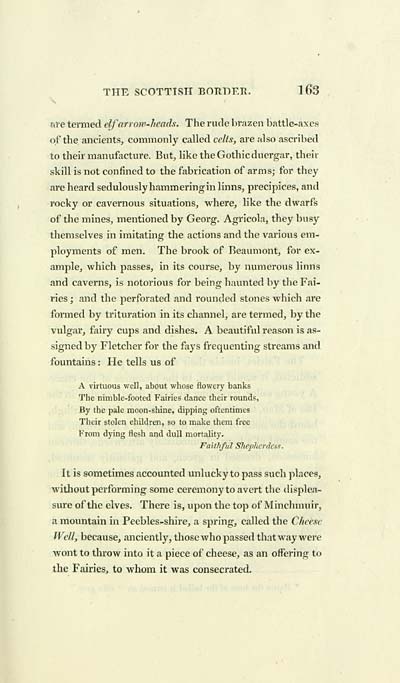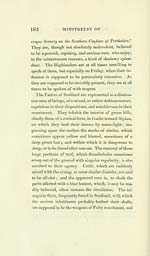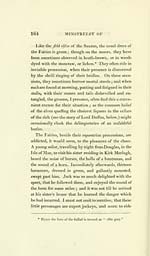Download files
Complete book:
Individual page:
Thumbnail gallery: Grid view | List view

THE SCOTTISH BOUDER. l63
\
ftte termed elf arrow-heads. The rude brazen battle-axes
of the ancients, commonly called cells, are also ascribed
to their manufacture. But, like the Gothic duergar, their
skill is not confined to the fabrication of arms; for they
are heard sedulously hammeringin linns, precipices, and
rocky or cavernous situations, where, like the dwarfs
of the mines, mentioned by Georg, Agricola, they busy
themselves in imitating the actions and the various em-
ployments of men. The brook of Beaumont, for ex-
ample, which passes, in its course, by numerous linns
and caverns, is notorious for being haunted by the Fai-
ries ; and the perforated and rounded stones which are
formed by trituration in its channel, are termed, by the
vulgar, fairy cups and dishes. A beautiful reason is as-
signed by Fletcher for the fays frequenting streams and
fountains : He tells us of
A virtuous well, about whose flowery banks
The nimble-footed Fairies dance their rounds.
By the pale moon-shine, dipping oftentimes
Their stolen children, so to make them free
From dying flesh and dull mortality.
Faithful Shephcrdcsi;.
It is sometimes accounted unlucky to pass such places,
without performing some ceremony to avert the displea-
sure of the elves. There is, upon the top of Minchmuir,
a mountain in Peebles-shire, a spring, called the Cheese
fVell, because, anciently, those who passed that way were
wont to throw into it a piece of cheese, as an offering to
the Fairies, to whom it was consecrated.
\
ftte termed elf arrow-heads. The rude brazen battle-axes
of the ancients, commonly called cells, are also ascribed
to their manufacture. But, like the Gothic duergar, their
skill is not confined to the fabrication of arms; for they
are heard sedulously hammeringin linns, precipices, and
rocky or cavernous situations, where, like the dwarfs
of the mines, mentioned by Georg, Agricola, they busy
themselves in imitating the actions and the various em-
ployments of men. The brook of Beaumont, for ex-
ample, which passes, in its course, by numerous linns
and caverns, is notorious for being haunted by the Fai-
ries ; and the perforated and rounded stones which are
formed by trituration in its channel, are termed, by the
vulgar, fairy cups and dishes. A beautiful reason is as-
signed by Fletcher for the fays frequenting streams and
fountains : He tells us of
A virtuous well, about whose flowery banks
The nimble-footed Fairies dance their rounds.
By the pale moon-shine, dipping oftentimes
Their stolen children, so to make them free
From dying flesh and dull mortality.
Faithful Shephcrdcsi;.
It is sometimes accounted unlucky to pass such places,
without performing some ceremony to avert the displea-
sure of the elves. There is, upon the top of Minchmuir,
a mountain in Peebles-shire, a spring, called the Cheese
fVell, because, anciently, those who passed that way were
wont to throw into it a piece of cheese, as an offering to
the Fairies, to whom it was consecrated.
Set display mode to: Large image | Transcription
Images and transcriptions on this page, including medium image downloads, may be used under the Creative Commons Attribution 4.0 International Licence unless otherwise stated. ![]()
| Early Gaelic Book Collections > J. F. Campbell Collection > Minstrelsy of the Scottish border > Volume 2 > (175) |
|---|
| Permanent URL | https://digital.nls.uk/80616791 |
|---|
| Description | Vol. II . |
|---|---|
| Shelfmark | Cam.2.d.18 |
| Attribution and copyright: |
|
| Description | Volumes from a collection of 610 books rich in Highland folklore, Ossianic literature and other Celtic subjects. Many of the books annotated by John Francis Campbell of Islay, who assembled the collection. |
|---|
| Description | Selected items from five 'Special and Named Printed Collections'. Includes books in Gaelic and other Celtic languages, works about the Gaels, their languages, literature, culture and history. |
|---|

